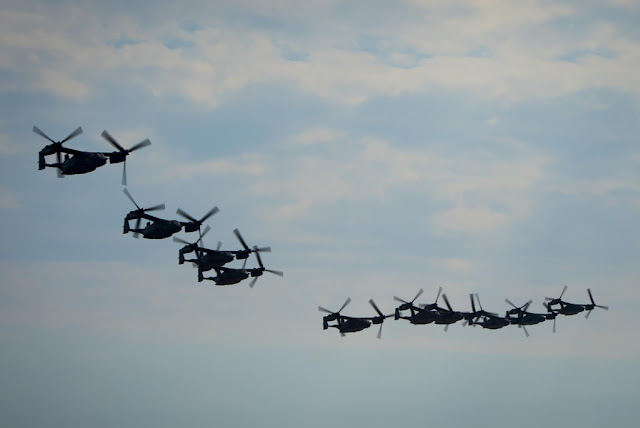IMPRESSIVE FORMATION OF TEN CV22 OSPREYS
It's the first time in U.S. Air Force history that 10 CV-22s fly in formation simultaneously.
 |
| Ten CV-22 Ospreys in flight formation |
CV-22 Osprey assigned to the 8th Special Operations Squadron at Hurlburt Field, Fla., and the 20th SOS at Cannon Air Force Base, N.M., fly in formation over Hurlburt Field Feb. 3, 2017. This training mission was the first time in U.S. Air Force history that 10 CV-22s flew in formation simultaneously.
The CV-22 Osprey is a tiltrotor aircraft that combines the vertical takeoff, hover and vertical landing qualities of a helicopter with the long-range, fuel efficiency and speed characteristics of a turboprop aircraft. Its mission is to conduct long-range infiltration, exfiltration and resupply missions for special operations forces.
This versatile, self-deployable aircraft offers increased speed and range over other rotary-wing aircraft, enabling Air Force Special Operations Command aircrews to execute long-range special operations missions. The CV-22 can perform missions that normally would require both fixed-wing and rotary-wing aircraft. It can take off vertically and, once airborne, the nacelles (engine and prop-rotor group) on each wing can rotate into a forward position.
The Osprey is equipped with integrated threat countermeasures, terrain-following radar, forward-looking infrared sensor and other advanced avionics systems that allow it to operate at low altitude in adverse weather conditions and medium- to high-threat environments.
The CV-22 is the Special Operation Forces variant of the U.S. Marine Corps MV-22 Osprey. The first two test aircraft were delivered to Edwards Air Force Base, Calif., in September 2000. The 58th Special Operations Wing at Kirtland AFB, N.M., began Osprey aircrew training with the first two production aircraft in August 2006.
The first operational aicraft was delivered to U.S. Air Force Special Operations Command in January 2007. Initial operational capability was achieved in 2009. A total of 51 aircraft are scheduled to be delivered by the end of 2019.
Source and Photo credit: USAF




